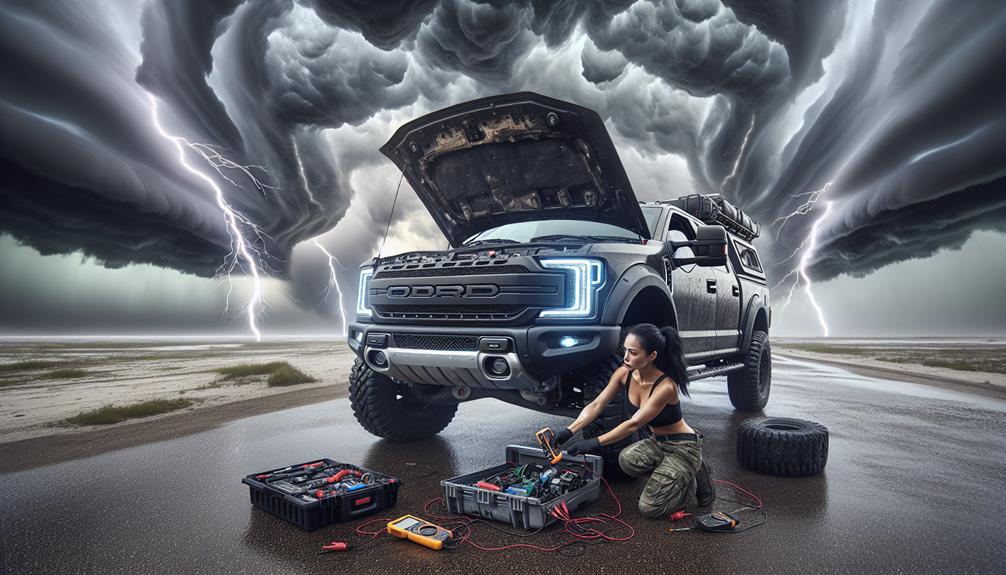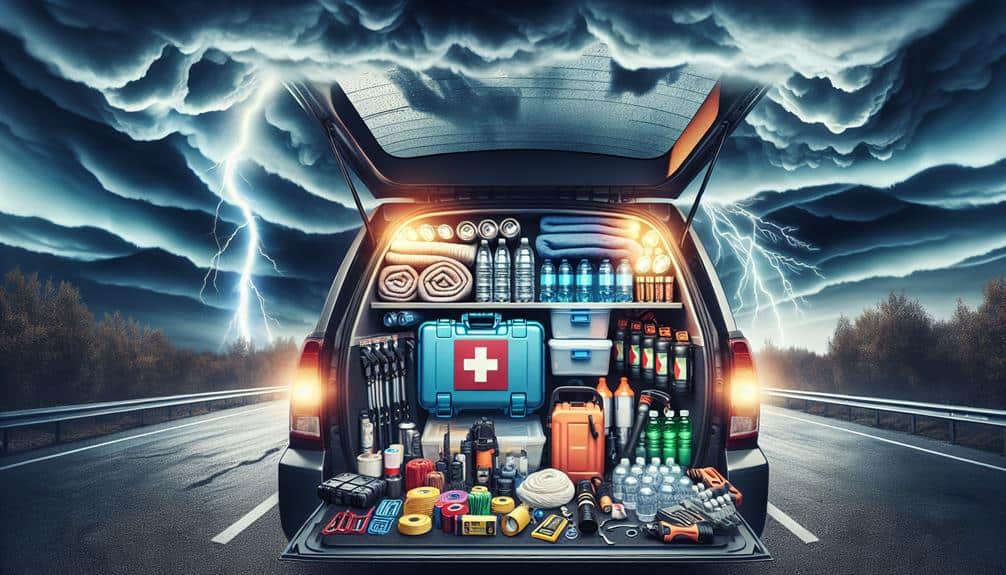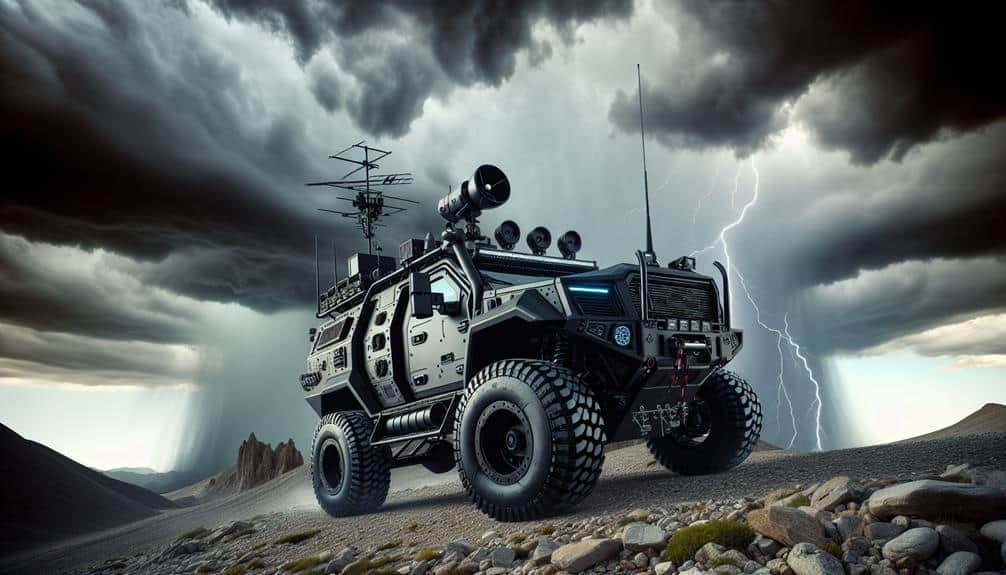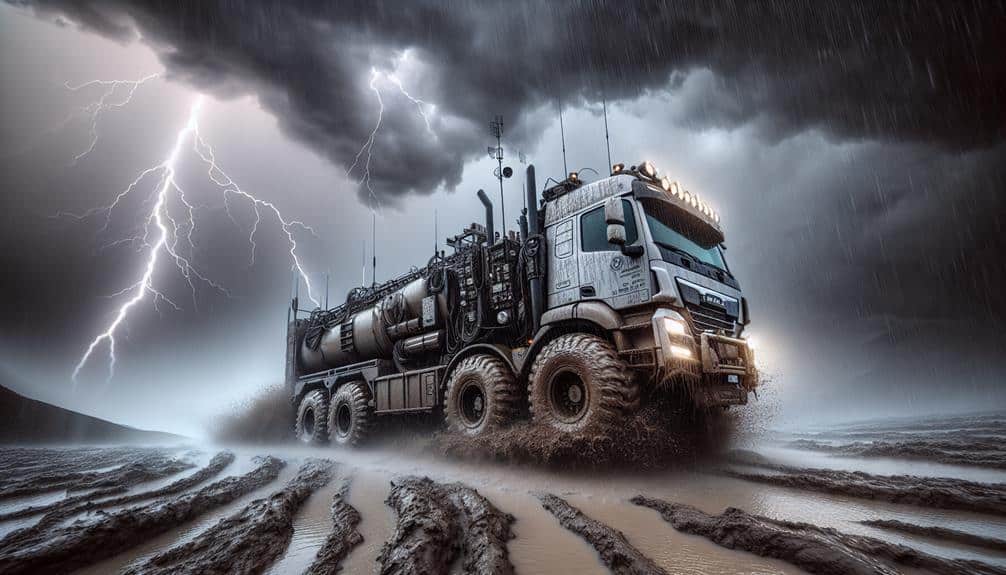Maintaining our storm chasing vehicle requires meticulous attention to key aspects. We need to perform regular engine check-ups, focusing on spark plugs and air filters. Tire inspections and rotations every 5,000 to 7,000 miles are essential for safety and efficiency. Keeping a close eye on brake pads, lines, and calipers guarantees reliable stopping power. Regularly checking and changing oil, coolant, and brake fluid levels prevent engine and braking issues. Inspecting battery connections and wiring, along with suspension and steering components, keeps our electrical and handling systems in top shape. Stocking an emergency kit with essentials ensures we're always prepared. Let's explore each tip further for a thorough upkeep.
Key Points
- Ensure regular engine inspections, focusing on spark plugs and air filters, for reliable performance in varying storm conditions.
- Maintain optimal tire pressure and tread wear to ensure safe and efficient driving on unpredictable roads.
- Regularly check brake pads and fluid levels for dependable stopping power during sudden storm-related stops.
- Inspect battery and alternator functions to prevent electrical failures in high-demand storm situations.
Regular Engine Check-Ups
Regular engine inspections are crucial to ensuring our storm chasing vehicle operates at peak performance, minimizing the risk of mechanical failure during important moments. To optimize our engine runs smoothly, we need to focus on the spark plug and air filter, both vital components.
First, let's talk about spark plugs. These small devices ignite the air-fuel mixture inside the engine's cylinders, powering the vehicle. Worn or fouled spark plugs can lead to misfires, reduced fuel efficiency, and even engine damage. We should inspect them regularly, looking for signs of wear, carbon buildup, or oil fouling. Replacing spark plugs every 30,000 miles or as recommended by the manufacturer ensures optimal engine performance.
Next, the air filter plays an essential role in maintaining engine health by preventing dirt, debris, and other contaminants from entering the engine. A clogged air filter restricts airflow, reducing engine efficiency and increasing fuel consumption. We should check the air filter every 12,000 to 15,000 miles, or more frequently if we operate in dusty environments. Replacing it when dirty is a simple yet effective way to keep our engine breathing freely.
Tire Inspection and Rotation
In addition to engine maintenance, we must give equal attention to tire inspection and rotation to guarantee our storm chasing vehicle remains safe and reliable on the road. Tire pressure monitoring is vital; we should check the pressure at least once a week. Under-inflated tires can decrease fuel efficiency and increase the risk of blowouts.
We should also perform a thorough tread wear analysis. Uneven tread wear can indicate misalignment or balance issues, which can affect handling and stability, especially in extreme weather conditions.
Alignment adjustments are another essential element. Misaligned wheels can cause rapid tire wear and compromise our ability to navigate through storm-ridden terrains. Regular alignment checks will secure our vehicle tracks straight and true.
Additionally, balance checks are necessary to avoid vibrations that could impact our control over the vehicle. Properly balanced tires contribute to a smoother ride and extend tire life.
Rotating our tires every 5,000 to 7,000 miles ensures even wear, enhancing performance and longevity. By following these detailed steps in tire inspection and rotation, we can maximize our vehicle's safety and reliability, allowing us the freedom to chase storms with confidence.
Brake System Maintenance
Maintaining a fully functional brake system is critical to guaranteeing our storm chasing vehicle can stop effectively under all conditions. First, let's prioritize brake pad replacement. We need to inspect our brake pads regularly, especially before heading into storm-prone areas. Worn brake pads can compromise stopping power, so replacing them promptly guarantees peak performance.
Next, brake line inspection is essential. We should check for any signs of wear, corrosion, or leaks in the brake lines. Damaged brake lines can lead to brake failure, putting us at risk during high-speed chases. By guaranteeing our brake lines are in top condition, we maintain the reliability of our braking system.
Rotor resurfacing is another critical task. Over time, rotors can become warped or uneven, leading to vibrations and reduced braking efficiency. Resurfacing the rotors guarantees they provide a smooth, even surface for the brake pads, enhancing overall braking performance.
Lastly, caliper maintenance shouldn't be overlooked. Calipers are responsible for applying pressure to the brake pads, and any malfunction can severely impact braking effectiveness. Regularly inspecting and servicing the calipers keeps them in prime working order, guaranteeing our vehicle can handle sudden stops when necessary.
Fluid Level Monitoring
Let's start with regular oil checks to guarantee our engine runs smoothly under extreme conditions.
We need to inspect the coolant system frequently to prevent overheating.
Additionally, monitoring brake fluid levels is vital for maintaining peak braking performance during high-speed chases.
Regular Oil Checks
Regularly checking the oil level in our storm chasing vehicle is essential to confirm the engine operates efficiently and prevents potential breakdowns. A well-maintained oil system guarantees that the engine's moving parts are adequately lubricated, reducing friction and heat.
To achieve peak engine performance, we should conduct regular oil changes and filter replacements. This practice helps remove contaminants that accumulate over time, preserving the integrity of the engine.
First, we need to inspect the oil level using the dipstick, verifying the vehicle is parked on level ground. If the oil is below the minimum mark, it's time to add more.
When conducting an oil change, we must drain the old oil completely and replace it with the manufacturer-recommended grade. Equally important is replacing the oil filter, which traps debris and prevents it from circulating through the engine.
Neglecting these steps can lead to reduced engine performance and increased wear and tear. By maintaining the oil system, we enhance the engine's longevity and reliability, which is crucial during the rigorous demands of storm chasing.
Let's keep these checks routine to ensure our vehicle is always ready for the next chase.
Coolant System Inspection
Just as we meticulously monitor our vehicle's oil levels, we must also check the coolant system regularly to prevent engine overheating during demanding storm chases. Maintaining optimal coolant levels is essential for engine health. Begin by ensuring the coolant reservoir is filled to the recommended level. If it's low, top it off with the appropriate mixture of antifreeze and water.
Performing a radiator flush is necessary to remove any sediment and contaminants that can impede the cooling system's efficiency. Follow the manufacturer's guidelines for the correct procedure and frequency of a radiator flush.
Next, inspect the thermostat to confirm it's functioning correctly. A faulty thermostat can lead to improper coolant flow, causing the engine to overheat.
Examine the water pump for any signs of wear or leakage. The water pump is crucial for circulating coolant through the engine, and any malfunction can lead to significant issues.
Also, scrutinize all hoses connected to the coolant system. Look for cracks, leaks, or soft spots, and replace any damaged hoses immediately to avoid a potential breakdown.
Brake Fluid Levels
Checking brake fluid levels is essential for guaranteeing reliable braking performance during intense storm chases. We need to start by locating the brake fluid reservoir, usually found near the master cylinder under the hood. Make sure the vehicle is on a level surface before inspecting the fluid level through the reservoir's transparent walls. The fluid should be between the 'MIN' and 'MAX' marks.
Brake fluid contamination can severely impact braking efficiency. We should examine the fluid's color and clarity—fresh brake fluid is typically clear or light amber. If it appears dark or cloudy, it's time for a replacement. Contaminants can degrade the fluid's performance, leading to brake failure, especially under the stress of storm chasing.
It's also important to regularly check for brake fluid leaks. Examine the brake lines, hose connections, and calipers for any signs of fluid leakage. Leaks can compromise the brake system, reducing hydraulic pressure and making it harder to stop quickly—a dangerous scenario when facing severe weather.
Electrical System Checks

Securing the reliability of our storm chasing vehicle's electrical system involves meticulously inspecting battery connections, alternator function, and wiring integrity.
First, we need to measure the battery voltage using a multimeter. A fully charged battery should read between 12.6 and 12.8 volts when the vehicle is off. If the voltage is below this range, it's essential to either recharge or replace the battery.
Next, we examine the wiring harness for any signs of wear or damage. Frayed or exposed wires can lead to short circuits, which are particularly risky when facing severe weather. We should also verify all connections are secure and corrosion-free. A simple application of dielectric grease can help safeguard these connections from moisture and oxidation.
Checking the alternator function is also vital. We start the engine and measure the voltage again; it should read between 13.7 and 14.7 volts. If not, the alternator might need servicing. Additionally, we inspect the serpentine belt for any signs of wear, as a faulty belt can hinder the alternator's performance.
Suspension and Steering Care
Let's focus on the suspension and steering systems, ensuring that our vehicle can handle rough terrains during storm chasing.
We need to regularly inspect suspension components for wear and damage, paying close attention to shocks, struts, and bushings.
Additionally, let's check steering fluid levels frequently to maintain best steering responsiveness and prevent potential leaks.
Inspect Suspension Components Regularly
Regular examination of your vehicle's suspension components is crucial to maintaining peak handling and safety during storm chasing expeditions. We need to make sure that every part of our suspension system is in top condition to navigate the unpredictable terrains we encounter.
A critical element is the shock absorber. Over time, these components wear out, leading to reduced stability and control. Regular shock absorber replacement prevents these issues, ensuring our vehicle can handle sudden maneuvers and rough roads.
Another key aspect to monitor is the vehicle's alignment. Misalignment can cause uneven tire wear, steering problems, and increased fuel consumption. By consistently performing alignment adjustments, we guarantee our vehicle tracks straight and true, even under the most challenging conditions. This not only enhances safety but also prolongs the life of our tires and suspension components.
Let's not underestimate the importance of inspecting bushings, ball joints, and tie rods. These parts contribute significantly to the overall performance of the suspension system. Any signs of wear or damage should be addressed immediately.
Check Steering Fluid Levels
In addition to maintaining the suspension components, we must regularly check the steering fluid levels to guarantee peak steering performance during our storm chasing adventures. Proper steering system maintenance is essential for making sure our vehicle responds accurately and swiftly to our input, critical when moving through unpredictable weather.
Steering fluid benefits are numerous: it lubricates the moving parts, reduces friction, and prevents wear and tear. But the fluid level importance can't be overstated; low levels can lead to increased steering effort and potential component damage.
Here are a few proper care techniques to keep our steering system in top condition:
- Locate the reservoir: Identify the power steering fluid reservoir, usually marked and easily accessible under the hood.
- Check levels regularly: Use the dipstick or markings on the reservoir to ensure the fluid level is within the recommended range.
- Top off as needed: Add the appropriate type of steering fluid if levels are low, following the vehicle's manual instructions.
- Inspect for leaks: Routinely check for any signs of fluid leakage around the steering components.
Emergency Kit Preparation

Preparing an emergency kit is crucial to make certain that we're prepared for any unexpected situations while storm chasing. We need to include basic necessities like food supplies and water bottles. Non-perishable snacks, energy bars, and canned goods can sustain us during extended periods without access to food. Make sure we've enough water bottles to stay hydrated; a good rule of thumb is at least one gallon per person per day.
In addition to sustenance, having a thorough first aid kit is crucial. Our kit should include bandages, antiseptic wipes, pain relievers, and any personal medications. This enables us to handle minor injuries on the road. For more serious situations, we must have a list of emergency contacts readily accessible. This list should include local emergency services, hospitals, and a trusted contact who knows our whereabouts.
Let's also pack tools like flashlights, batteries, a multi-tool, and a portable phone charger. These tools can assist in various scenarios, from vehicle breakdowns to power outages.
A blanket, rain gear, and extra clothing can protect us against the elements. By preparing thoroughly, we ensure our safety and readiness for any challenge storm chasing throws our way.
Frequently Asked Questions
How Do I Protect My Vehicle From Hail Damage During Storms?
Let's protect our vehicle from hail damage by using DIY hail protection methods. Secure vehicle covers specifically designed for hail. These covers provide a cost-effective solution, ensuring our freedom to chase storms without worrying about damage.
What Type of Insurance Is Best for Storm Chasing Vehicles?
We can't predict the storm, but we can prepare for it. Extensive coverage, combined with liability coverage, is essential. Choosing the right deductible options and coverage limits guarantees our storm chasing vehicle is protected against all odds.
How Can I Improve My Vehicle's Aerodynamics for Storm Chasing?
To improve our vehicle's aerodynamics for storm chasing, we can reduce wind resistance through modifications like adding a streamlined roof rack and installing stability upgrades such as side skirts and a rear spoiler for enhanced performance.
Are There Specific Brands of Vehicles Recommended for Storm Chasing?
For storm chasing, we recommend vehicles known for durability and safety, like Toyota and Ford. Their brand reputation and reliability guarantee we can focus on the storm, confident our vehicle can handle extreme conditions.
How Do I Secure My Equipment Inside the Vehicle During High Winds?
In the face of winds that could blow us to Oz, we anchor our equipment using heavy-duty straps and mounts. This guarantees equipment safety and wind protection, improving vehicle security and storm preparedness for our wild pursuits.


